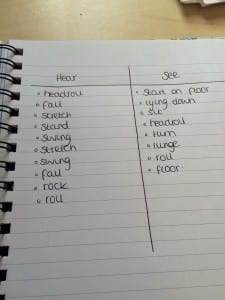“You are not an object in space. You are part of the space” (Halprin in De Spain, 2014, 109). This quote stands out to me because it makes me remember that you should use all of the space around you, as you are the one wanting to be seen and you shouldn’t have to stay in the background. The space is yours, use it.
This week made me realise, I am more attracted to quiet spaces, which I find are usually in the corners around the edge of the room. During the first exercise, we had to focus on our hearing and when we heard a sound we had to move around the room accordingly. I found this task quite difficult because I wasn’t sure if I was moving because I heard an actual sound or just because other people moved. I also found interesting, the fact that different people had similar intentions to each other, for example when I intended to move to a space, another person may have had the same idea, meaning my intentions would have had to change.
This next exercise seemed so simple, but who would have thought it would be so difficult to guess when two minutes had gone by? I found it very interesting that when I was sitting down, time seemed to creep by, but whilst I was walking around the room, time flew past; reminding me of something I have previously read – “Time slips through our fingers” (Buckwalter, 2010, 60) which I can definitely relate to.
The next task we did, made me realise a few of my own bad habits. Such as for some reason when improvising, I always seemed to stick to the same pattern. The beginning and end section of my improvisation was always longer and slower than my middle section. I think that the reason for this is because I always feel more comfortable starting off slow as this gives me time to settle into my movements, once I feel confident with the pace I am doing, I can then move onto the middle or the ‘climax’ as some might say, ending with slower movements which allows me to bring my improvisation to a graceful finish. Whereas in the future, I need to play around with my movements more in order to make them more interesting.
In the final exercise, the first score was structured making it seem far too organised, which made it quite dull to watch. However in the second score the dancers had more freedom, this made it a lot more enjoyable from an observer’s point of view because it was clear that people took more risks. This in my opinion was even funnier to watch because you could see the panic on people’s faces as a person entered another’s space, meaning the other dancer had to decide straight away to leave the space. For this, it needed quick thinking which I think contributed to the overall flow of the score, as the movements looked a lot more natural for the dancers. This contributed to my overall enjoyment of observing this final exercise.
Buckwalter, M. (2010) composing while dancing AN IMPROVISER’S COMPANION. USA: University Wisconsin Press, pages 60-90.
De Spain, K. (2014) Landscape of the Now. USA: Oxford University Press, pages 109-113
